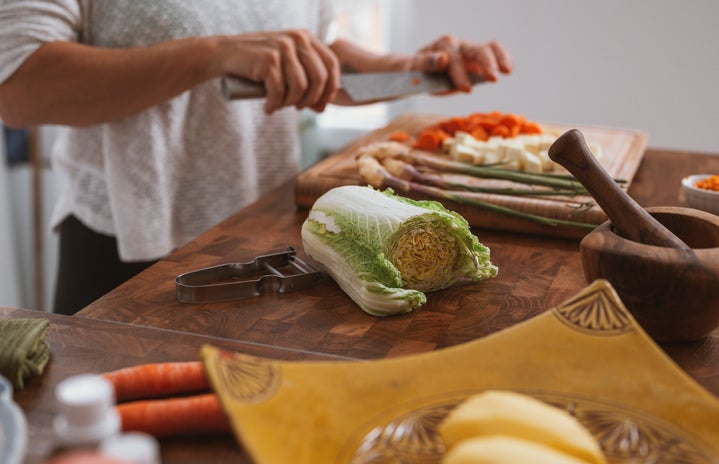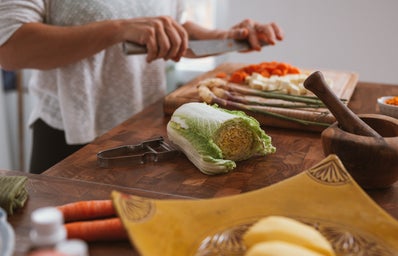School is back in session, and while that means bringing out the textbooks, it also means for many university students that it’s also time to bring out the kitchen utensils.
Living away from home, whether on or off-campus, requires meal prep and, of course, basic cooking skills for the everyday hustle. No, you may not be able to recreate grandma’s lasagna to perfection, or any household favourite right off the bat, but with a few fundamental tips, you’ll be ready to conquer both exams and the kitchen.
Kitchen Gear
First and foremost, regardless of your cooking skills, it takes pots, pans, and utensils to get your meals to the finish line. An ill-equipped kitchen is a no-go, so if you’re just getting started you’ll need basic gear.
- Measuring cups: its purpose is self-explanatory, but nonetheless, it is a handy essential for any prep.
- Mixing bowls: combining veggies, whipping up a marinade, or mixing meat for meatballs, you’ll want to get a set of bowls in various sizes to assist in the meal preparation (I recommend stainless steel).
- Colander: also known as a strainer, use this to rid your pasta, veggies, rice, and potatoes of excess water after a boil.
- Cutting boards: protect your kitchen counter and keep your chopping frenzy clean and contained; just make sure to give your cutting board a good wash after each use (otherwise, your apple slices will taste like garlic!)
- Grater: handy for shredding cheese on taco night, you can also grate fresh ginger and garlic, a variety of vegetables, and zest citrus fruits.
- Wooden spoons: these cook spoons are great because they are as durable as they are gentle (that is, they won’t scratch the bottoms and sides of your pots and pans unlike their metal-spoon counterparts). They also don’t conduct heat and will not leach possible harmful chemicals into the food. I see that as a win.
Other (obvious) honourable mentions include a potato masher, can-opener, spatula, whisk, and tongs.
Carolina’s Culinary Recommendation: An immersion blender is an excellent tool to blend food into delicious sauces, soups, and stews with minimal effort and maximum blending power.
Pans
- Saucepans: get a range of different-size saucepans so you can make delicious curries, stews, sauces (duh), as well as boil the heck out of your pasta, veggies, eggs, and ’taters.
- Frying pan: as the name implies, if it’s fried it probably belongs here.
- Wok: Asian cuisine lovers should never be without one. The wok is not only for stir-frying, it can also be used for boiling and making stews.
For more information, check out this helpful guide about all the different types of cookware you can use!
Now that we have tackled the abundance of kitchenware, we can cover foundational cooking how-tos.
Basic Knife Skills
Whether you’re meal prepping or just trying to make dinner, you need to know basic cutting skills. It will completely transform how you cook at home. Not only will having proper technique help speed up the prep time on your recipes (meaning less time cooking and more time eating), it will reduce the risk of injury.
Handling a knife is the first and foremost skill learned in culinary school. Once you nail the different cutting techniques you’ll be set, but ultimately practice is the key to mastering this skill.
My recommendation when starting out is rotating between three essential knives:
- Chef knife: used for cutting meat, carving, dicing vegetables, slicing herbs, and chopping nuts.
- Utility knife: good for chopping smaller foods and vegetables, allowing for more precise cutting work.
- Paring knife: small but mighty, it is used to cut, chop, and slice fruits and vegetables.
Oftentimes, you can find all three sold together as a set in grocery stores.
How To: Handling with caution, start with a good knife that’s sharp; contrary to popular belief, a dull blade is more dangerous than a sharp one. Dullness in a knife can make it harder to cut through tough foods which can cause it to slip and cut you in the process.
Find a few onions, potatoes, or other vegetables, and follow along with video tutorials. Some of the basic cuts include rough chop (large chunks), dice (small, equally-sized chunks), mince (tiny, tiny pieces), and chiffonade (cutting leaves and herbs into strips). Other foods require specific knife techniques — cauliflower and broccoli are cut into florets, for example, whereas fruits with pits need extra care to avoid injury.
See it in action: How To Master Basic Knife Skills
Cooking Basics
Pasta
Cooking pasta is one of the easiest dishes you can make. Truly, it is fool-proof. And the great news is once you know how to cook it you can customize it any which way you want: bottled (or homemade) marinara sauce, store-bought pesto, flavoured olive oils and loads of pre-shredded Parmesan cheese.
Here are my tips to cook the perfect pasta:
Fill either a large saucepan or stockpot with water and bring to a rolling boil. Then add your pasta, along with a tablespoon of olive oil to the water to prevent the pasta from sticking together.
Adding salt to the water, while optional, can add flavour and help the pasta absorb sauce better.
Keep in mind that different shapes/types of pasta may have different cooking times, although most of the time it ranges between 9-11 minutes or until al dente (meaning ‘to the tooth’); a tender but firm bite.
Drain your cooked pasta in a colander in the sink and add it back into the pot. And voila you’re done!
From here is the fun part. Add salt and butter to the pasta for a simple flavour. Toss in chilli flakes in garlic powder if you want something more, or add sauce. Steamed vegetables or grilled chicken is also another great addition. Want to make a seafood linguini? Simply defrost frozen cooked shrimp in a microwave!
Chicken
For this popular poultry, here’s how to buy, store and cook it:
Check the “best by” date when buying fresh chicken and get the latest possible date.
Freezing raw chicken is great for later use, but keep in mind that you must use it within two days of dethawing in the fridge. Don’t leave raw or frozen chicken at room temperature and never leave cooked chicken out at room temperature for longer than two hours.
When preparing your chicken, rinse raw chicken pieces with cold water and pat them dry with a paper towel before you start your recipe. Raw chicken carries salmonella, so it’s important to clean every surface that comes into contact with raw chicken or its juices with hot, soapy water.
When cooking chicken, it should always be cooked throughout. Check for doneness by making a slit in the thickest part of the chicken piece, then look to see if it is cooked through to the middle. The juices from the chicken should run clear (not pink).
When marinating chicken, don’t use the same marinade that was on your raw chicken as a basting sauce during cooking or a dipping sauce afterward. Instead, put some marinade aside before adding the chicken to use for basting and dipping. This will prevent cross-contamination.
If you want to bake chicken, preheat the oven to around 400ºF (about 200°C) and line a sheet pan with parchment paper. Place chicken breasts or thighs on the parchment, drizzle them with oil, and sprinkle with salt and pepper (and other seasonings you want). Flip them and repeat.
Bake away until chicken is cooked (using the doneness method above), and start checking after 20 minutes, but it usually takes 30–40 minutes to finish. This same process can be done with fish as well.
Don’t have an oven? Not to worry! Here’s a simple, student-friendly way to cook chicken on the stovetop.
Salads
If your idea of salad is plain lettuce, it’s no wonder you’re hesitant about chomping into a salad at lunch.
A great way to consume more greens in your daily diet is to get more creative with it – this approach works for just about any veggie-dish, not only salads.
To elevate your salad-eating experience start by trying out different types of salad greens such as arugula, spinach, and kale. Add roasted or raw veggies, nuts or seeds, and slices of fruit such as peaches or strawberries. Adding proteins such as chickpeas, chicken or salmon make for a full meal.
Pour over a simple vinaigrette – a mixture of balsamic vinegar and olive oil with salt, pepper, and herbs – and it all comes together.
Roasting Vegetables
Another straightforward process to help turn a pile of root vegetables into a yummy perfect-for-fall side.
Heat your oven to 350ºF (about 177°C) and start chopping.
Douse the chopped veggies with oil, salt and pepper (or try my personal favourite, bell pepper and roasted garlic seasoning) on a baking sheet. Bake until tender and just starting to brown, and that’s literally it. You can make every meal more delicious – and get your daily vegetable intake – with minimal effort.
Other Things to Consider…
The Importance of Meal-Planning
Making a meal plan for the week ahead is super helpful. Why?
It will help make the grocery shopping trip more seamless as you know exactly what you need to buy. As a result, you’ll save money and time because you won’t be shopping blindly or over-buying. Instead, entering the store with a game-plan, grocery list in tow, will give you a clear goal. Additionally, it will help prevent food from getting thrown out or spoiling.
Not sure what to make for dinner? Search for recipes using keywords of your fridge contents such as “cream cheese + spinach + chicken” Not only will you find a recipe, but it will also help you get through all your groceries before they go bad.
Meat and Vegetable Sanitation
As mentioned earlier, every step in handling, cooking and storing meat, poultry, or fish safely is essential to avoid any kind of food contamination. As a budding cook, you should know how to check its freshness and doneness while cooking, how to clean it and pack it properly for storing.
YouTube is your best bet for comprehensive videos discussing the proper preparation of a variety of meats.
Similarly, managing fruits and vegetables and checking for their freshness is just as important as handling meat. The best way to test how fresh the produce is to handle it and inspect it to ensure that it is clean and undamaged. Avoid produce at the supermarket with bruises and mushy spots. A bonus tip: buy in-season items whenever possible. Not only will it be fresh and more likely local but delicious also.
Spices
Every great dish is elevated further with seasoning. Here are some spices every good cook should have in their pantry (aside from standard salt and pepper):
Garlic Powder
A great substitute for fresh garlic cloves, this spice is made from finely ground, dehydrated garlic. With a long shelf life, it’s an awesome time-saver in recipes including a variety of soups, roasts or pasta sauces. Personally, I add a dash into the saucepan every time I make Alfredo sauce (thank me later.)
Paprika
Made from dried and ground red peppers, use it to add colour or a mild peppery flavour to any dish. Alternatively, hot paprika uses a spicy variety of peppers that pack heat. Another option is smoked paprika giving a subtle wood-fired flavour. Try it in chilli or in steak rub.
Cayenne
When you need a bit of heat, a pinch or two of cayenne pepper does the job. It’s excellent in many different types of dishes, from roasted vegetables such as carrots and potatoes to corn on the cob or soup.
Cumin
Cumin is an essential spice great for curries and chutneys, giving a hot, slightly nutty flavour. It also works well in a variety of rice dishes, stews and soups, and most meat recipes. However, be cautious when cooking with cumin as its flavour can easily overtake a dish. Remember you can always add more later.
Turmeric
Serving not only as a potent anti-inflammatory and antioxidant, but its golden hue color is also just as remarkable. The flavour it offers is huge – a notable player in many curry dishes – and has an earthy and bitter taste, with a bit of peppery spice. Rice, quinoa, and couscous also all mingle well with turmeric. Adding cracked pepper significantly increases the effectiveness of turmeric, so be sure to add some to the mix!
Chili Powder
This spice mixture made with cayenne and other dried peppers, along with cocoa, garlic and onion, offers complex levels of heat and a wonderful depth of flavour. Use this in your chilli (of course), add it to rubs, soups, stews, and a variety of Latin dishes.
Oregano
Oregano has an herbaceous, slightly citrusy flavour that plays well with others. Some common culinary uses of oregano include tomato-centric recipes, like pizza and pasta sauce. In other words, it is definitely a must in most Italian dishes. It also can be combined with olive oil to create flavorful vinaigrettes, and marinades for lamb, chicken, and beef dishes. Dried oregano works great but fresh is even more powerful.
Dried Rosemary & Thyme
A staple in a lot of Mediterranean and French cooking, rosemary has a woodsy, peppery, distinct aromatic quality you won’t find in other herbs. It is also stellar in savoury breads and rolls. Thyme is an intensely fragrant herb that works well with a wide variety of meats, especially poultry, and vegetables. It also finds its way into most stuffing recipes.
Ground Ginger
This spice provides a warm, spicy flavour great in cookies and also for spice rubs and marinades. Fresh ginger has a stronger, sharper taste but the ground kind can hang out in your kitchen a lot longer.
Things to keep in mind: When buying spices you probably won’t use very often, look for small bottles or resealable bags so as not to waste as much (it’s also more cost-efficient). Compared to the fresh stuff, dried spice and herb alternatives have a longer shelf life, perfect for any busy student, offering convenience. Just remember to change them out after a while before the flavour goes flat.
Recipe Inspiration
Now that you have some culinary knowledge to start your cooking journey (a cornerstone in the world of adulting), where can you find great recipes? In my experience, you can find them just about anywhere.
I often find inspiration in recipe books from the cooking section of my local library or bookstore, in magazines, as well as from family and friends. A recipe cut out from an old newspaper has become my family’s favourite way to make Chinese potstickers. My hairdresser shared with me how they make Thai Galangal Chicken Soup (Tom Ka Gai). My go-to Biryani recipe came from a neighbour who taught me.
Alternatively, the internet has a plethora of recipes to search for. Some of my favourite cooking websites are: AllRecipes, Epicurious, SimplyRecipes
These sites are great as they offer a vast variety of meal ideas, including homemade recipes people from across the globe upload to share with others. Over time the accumulation and diversity of dishes you come to discover and love create a great arsenal of meals to share with loved ones.
The Grand Takeaway
Now that you have a launching point to start cooking, you’ll come to be able to navigate around your kitchen like a pro. The basics are easy and once you get the hang of it, you’ll be able to provide joy and nourishment for friends, family, and most importantly yourself.


